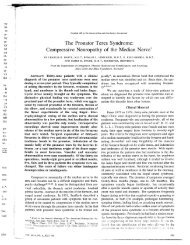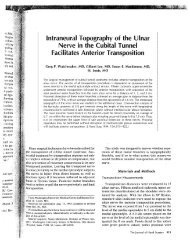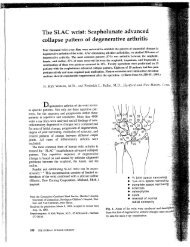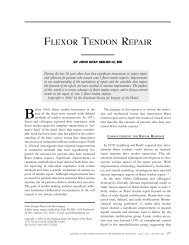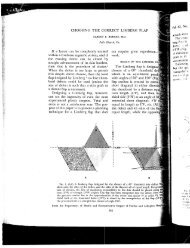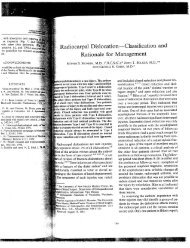Pollicization of the Index Finger
Pollicization of the Index Finger
Pollicization of the Index Finger
Create successful ePaper yourself
Turn your PDF publications into a flip-book with our unique Google optimized e-Paper software.
1616 DIETER BUCK-GRAMCKO<br />
Su mmary -<br />
The experiences with 100 operations <strong>of</strong> pollicization <strong>of</strong> <strong>the</strong> index finger in congenital<br />
deformities <strong>of</strong> <strong>the</strong> thumb in seventy-three patients are reported on. The operation<br />
is indicated in aplasia and in hypoplasia if <strong>the</strong>re is no stable metacarpopha_<br />
langeal joint and <strong>the</strong>re are adduction contracture and poor mobility due to abnormal_<br />
ities <strong>of</strong> aluscles and tendons. The operative technique was improved by <strong>the</strong> experiences<br />
in twelve years <strong>of</strong> use. Most important are <strong>the</strong> bone fixation and <strong>the</strong> muscle<br />
stabilization. In transformation <strong>of</strong> an index finger into a thumb it is necessary to<br />
shorten <strong>the</strong> ray, to rotate it sufficiently, and to give it <strong>the</strong> right angle <strong>of</strong> abduction.<br />
The shortening takes place in <strong>the</strong> metacarpal bone with preservation <strong>of</strong> its head:<br />
<strong>the</strong> metacarpophalangeal joint becomes now <strong>the</strong> carpometacarpal joint and <strong>the</strong> metacarpal<br />
head <strong>the</strong> new trapezium. For preventing a hyperextension deformity it is<br />
necessary to rotate <strong>the</strong> metacarpal head For good muscle stabilization and good<br />
mobility <strong>the</strong> two interossei <strong>of</strong> <strong>the</strong> index finger have to be detached and to be fixed in<br />
<strong>the</strong> shortened position on both sides <strong>of</strong> <strong>the</strong> new thumb to <strong>the</strong> mobilized lateral slips<br />
<strong>of</strong> <strong>the</strong> dorsal aponeurosis. This new manner <strong>of</strong> muscle fixation gives a very good<br />
<strong>the</strong>nar eminence not only in respect to appearance but also in function with full or<br />
nearly full opposition and abduction. It requires a new skin incision with a dorsoradial<br />
skin flap for covering <strong>the</strong> gap between <strong>the</strong> wound edges <strong>of</strong> <strong>the</strong> former proximal<br />
phalanx broadened by <strong>the</strong> muscle masses. The excellent results show a surprising ....<br />
adaptation <strong>of</strong> bones and s<strong>of</strong>t tissues due to function and growth--a reason for an<br />
earl), performance <strong>of</strong> <strong>the</strong> operation. :.<br />
References<br />
1. BROOKS, DONAL: In Rehabilitation <strong>of</strong> <strong>the</strong> Hand. Ed. 2, pp. 336-348. Edited by C. B. Wynn<br />
Parry. London, Butterworths, 1966.<br />
2. BUCK-GRAMCKO, DIETER: Operative Behandlung einer Spiegelbild-Deformit~t der Hand.<br />
Ann. Chir. Plast., 9; 180-183, 1964.<br />
3. BUcK-GRAMCKO, DIETER: Daumenrekonstruktion bei Aplasie und Hypoplasie. Kiln. Med.,<br />
21; 325-329, 1966.<br />
4. BUCK-GRAMCKO, DIETER: Indikation und Technik der Daumenbildung bei Aplasie und<br />
Hypoplasie. Chit. Plast. Reconstr., 5:46-51. 1968.<br />
5. EDGERTON, M. T.: SNYDER, G. B.; and WEB~, W. L.: Surgical Treatment <strong>of</strong> Congenital<br />
Thumb Deformities (Including Psychological Impact <strong>of</strong> Correction). J. Bone and Joint<br />
Surg., 47-A-" 1453-1474, Dec. 1965.<br />
6. GOSSET, J.: La poIIicisation de l’index (Technique chirurgicale). J. Chir., 65:403-411, 1949.<br />
7. HARRISON, S. H.: Restoration <strong>of</strong> Muscle Balance in <strong>Pollicization</strong>. Plast. Reconstr. Surg., 34;<br />
236-240, 1964.<br />
8. HARRISOr~, S. H.: Pollicisation in Cases <strong>of</strong> Radial Club Hand. British J. Plast. Surg., 23~<br />
192-200, 1970.<br />
9. HILGENFELDT, OTTO: Operativer Daumenersatz und Beseitigung v0n Greifst6rungen bei<br />
<strong>Finger</strong>verlusten. Stuttgart, Ferdinand Enke Verlag, 1950.<br />
10. LITTER, J. W.: The Neurovascular Pedicle Method <strong>of</strong> Digital Transposition for Reconstruction<br />
<strong>of</strong> <strong>the</strong> Thumb. Plast. Reconstr. Surg., 12:303-319, 1953.<br />
11. LITTLER, J. W.: Digital Transposition. In Current Practice in Orthopaedic Surgery, Vol. 3,<br />
pp. 157-172. St. Louis, The C. V. Mosby Co., 1966.<br />
12. RIORDhN, D. C.: Congenital Absence <strong>of</strong> <strong>the</strong> Radius. J. Bone and Joint Surg., 37-A:<br />
1140, Dec. 1955.<br />
13. WroTE, W. F.: Pollicisation for <strong>the</strong> Missing Thumb, Traumatic or Congenital. The Hand,<br />
1: 23-26, 1969.<br />
14. WHITE, W. F.: Fundamental Priorities in <strong>Pollicization</strong>. J. Bone and Joint Surg., 52-B: 438-<br />
443, Aug. 1970.<br />
DISCUSSION<br />
.DR. J. W. LITTLER, NEW YORK, N. Y.: Through a tragic pharmacological mishap<br />
Buck-Gramcko has ga<strong>the</strong>red this unprecedented series (100 cases) <strong>of</strong> thumb aplasia. His paper<br />
a splendid one and <strong>the</strong>refore a pleasure to discuss: its clarity is refreshing, <strong>the</strong> surgical approach<br />
is exact, and <strong>the</strong> functional reward for <strong>the</strong>se little patients is superior. His outstanding contribution<br />
gives great authority to this particular procedure.<br />
Several points, however, deserve emphasis. First: <strong>the</strong> surgical timing. For many years I<br />
have resisted transposing <strong>the</strong> radial digit into thumb position during infancy, believing that <strong>the</strong><br />
THE JOURNAL OF BONE AND JOINT SURGERY



